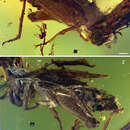Description
(
英語
)
由Zookeys提供
Female: Approximately 8.0 mm long measured from fastigium verticis to posterior apex of pronotum (Figs 1–3). Head hypognathous, robust and dorsoventrally elongate (Figs 4–5). Integument granulose; genae markedly so, bearing numerous tuberculae. Compound eyes large, globose, projecting somewhat dorsally; ventral margin acutely rounded. Vertex with low median carinula becoming lower as it crosses the fastigium, and two stronger, well-defined lateral carinae forming small dorsolaterally produced fastigial horns between compound eyes. Lateral foveae deep, longer than wide, deeper anteriorly than posteriorly. Fastigium verticis not projecting anteriorly beyond compound eyes. Interocular distance c. 0.30 mm. Frontal costa nascent immediately beneath fastigium, becoming prominent c. 0.25 mm from fastigial ridge and bifurcating at the lateral ocelli, diverging into two prominent ridge-like costal lobes between antennal torulae and ending at median ocellus. Frontal carina bifurcating c. 0.52 mm beneath median ocellus. Fronto-clypeal margin distinct, broadly emarginate Clypeus narrow; anterior margin with broad, shallow emargination. Labrum shield-like, markedly larger than clypeus with rounded apex. Mandible robust. Gena somewhat inflated with strongly granulose/tuberculate ornament; delimited anteriorly by a deep subocular furrow running the entire length of the fronto-genal region. Antennae filiform, with at least ten flagellomeres. Scape subcylindrical, approximately twice as large as pedicel and somewhat compressed laterally. Pedicel subspherical, narrower than scape but wider than flagellomeres. Flagellum at least 1.24 mm long. Flagellomeres cylindrical, longer than wide; flagellomere 3 approximately half as long as the others.
Pronotum robust, c. 6.55 mm long, with coarsely granulose ornament; anterior margin with small tectate process extending slightly above vertex of head; posterior process almost reaching apex of abdomen and terminating in a blunt and slightly upturned acuminate tip. Median carina forming distinct keel. Lateral carinae well-developed. Transverse sulci distinct, crossing and cutting the lateral carinae but not cutting the median carina. Thoracic sterna robust. Tegmen present, scale-like, longer than wide; venation indistinct, comprising numerous closed cells. Hind wing approx. 2.5 mm long, tightly folded (Fig. 6); costal lobe well-developed; Sc reaching costal margin almost reaching apex of wing; R and M entirely fused, running very close to Sc; area between R+M and Cu with numerous crossveins; CuA not visible; CuP approximating running close to 1A for its entire length; anal veins numerous.
Profemur 1.75 mm long, subquadrate in section with poorly developed carinae. Protibia at least 1.5 mm long and markedly more slender than profemur. Protarsus largely obscured by bubbles and debris in the amber. Mesofemur quadrate in section and similar in length to profemur but with carinae well-developed and complete for entire length of femur. Mesotibia 1.5 mm long, more slender than mesofemur but not as slender as protibia. Mesobasitarsus 0.2 mm long with bilobed euplantulae; second tarsomere 0.7 mm long, apically inflated with two strong pretarsal claws. Metafemur large and robust (Fig. 7), 5.5 mm long, with prominent upper and lower carinulae, dorsal keel and ventral carinae; superior and inferior marginal areas with transverse patches of rugose integument separated by smooth cuticle; medial area with prominent herringbone ornamentation comprising roughly diamond-shaped ‘cells’ of smooth cuticle, delimited by raised areas of rugose integument; femoral lobe low and distinctly rounded, not forming a spine; genicula bulbous with prominent dorsal process. Metatibia 5.0 mm long with prominent genicular bulb; 6 inner and 6 outer robust dorsal spines; 2 inner and 2 outer curved apical spurs, with inner spurs longer than outer spurs. Metabasitarsus robust, 1.0 mm long, with distinct, dorsal apical spine and two bilobed euplantulae situated in its basal half; second tarsomere much shorter, 0.3 mm long; third tarsomere almost as long as basitarsus, distinctly curved and somewhat inflated apically, bearing two pretarsal claws.
Abdomen at least 4.0 mm long, though apical damage prevents accurate measurement. Subgenital apically bilobed. Ovipositor approximately 1.0 mm long, with strong denticles on dorsal valvulae and fewer, smaller denticles on the ventral valvulae. Dorsal parts of terminalia (epiproct, cerci, etc.) obscured by bubbles and detritus.
Male: Unknown.
- 許可
- cc-by-3.0
- 版權
- Sam W. Heads, M. Jared Thomas, Yinan Wang
- 書目引用
- Heads S, Thomas M, Wang Y (2014) A remarkable new pygmy grasshopper (Orthoptera, Tetrigidae) in Miocene amber from the Dominican Republic ZooKeys 429: 87–100
- 作者
- Sam W. Heads
- 作者
- M. Jared Thomas
- 作者
- Yinan Wang
Distribution
(
英語
)
由Zookeys提供
INHS 10175, Early Miocene (Burdigalian) amber from the La Toca region, near Santiago de los Caballeros, Santiago Province, Dominican Republic. Well-preserved adult female in a piece of amber approximately 20 × 15 × 12 mm. Numerous syninclusions are also present within the piece, including: an indet. chalcid wasp (Hymenoptera: Chalcidoidea); an indet. proctotrupoid wasp (Hymenoptera: Proctotrupoidea); a single worker ant of the genus Solenopsis (Hymenoptera: Formicidae); numerous smaller ants, possibly of the genus Azteca (Hymenoptera: Formicidae); a springtail (Collembola); three net-winged midges (Diptera: Blephariceridae); numerous botanicals including a well-preserved flower bud and a leaf fragment with possible epiphytic fungus.
- 許可
- cc-by-3.0
- 版權
- Sam W. Heads, M. Jared Thomas, Yinan Wang
- 書目引用
- Heads S, Thomas M, Wang Y (2014) A remarkable new pygmy grasshopper (Orthoptera, Tetrigidae) in Miocene amber from the Dominican Republic ZooKeys 429: 87–100
- 作者
- Sam W. Heads
- 作者
- M. Jared Thomas
- 作者
- Yinan Wang

